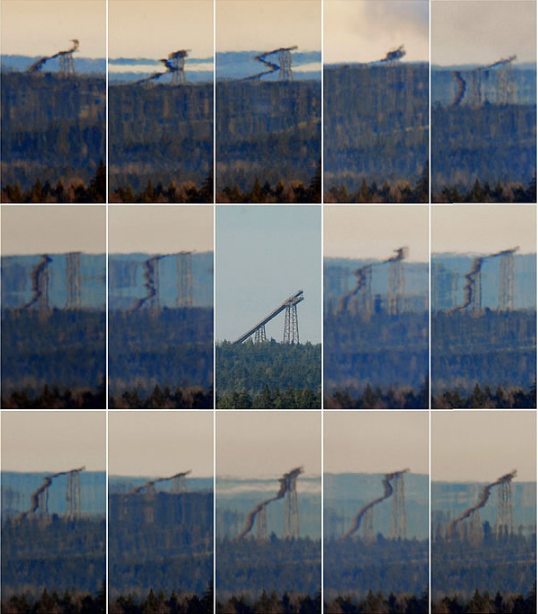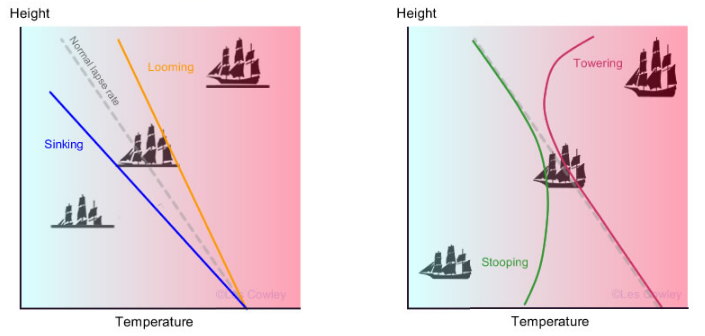OPOD - Errant Ski-slope
OPOD - Errant Ski-slope: A Fascinating Display of Atmospheric Optics
Have you ever seen a ski-slope appear serpent-like, writhing and twisting in the distance? Renowned atmospheric optics photographer Pekka Parviainen captured this mesmerizing phenomenon in Finland. The image showcases various distortions, with parts of the ski-slope being raised or lowered and vertically stretched or compressed. Additionally, miraging, which involves the presence of multiple images, can be observed. These distortions arise from a complex and ever-changing vertical atmospheric temperature profile, resulting in layers of varying air density. As rays of light traverse these layers, they undergo refraction or deviation, ultimately causing distant objects to appear vertically displaced or even distorted.
The different distortions seen in this captivating image evoke terms used by old-time sailors to describe similar effects observed in ships near the horizon. Let's explore these atmospheric optical phenomena further:
Looming: A Mystical Elevation
Looming refers to the apparent elevation of a distant object without any vertical stretching or compression. It occurs when there is a constant decrease in density with height, albeit steeper than usual. Essentially, a less steep fall in temperature with increasing altitude contributes to looming. This effect creates the illusion that the object is raised higher than its actual position.
Sinking: A Surreal Descent
On the other hand, sinking manifests as a lowering of the image without any vertical distortion. It arises from a less steep fall in density with height compared to normal conditions. When encountering sinking, the image seems to descend below its true location, captivating observers with its surreal descent.
Towering: When Images Reach New Heights
Imagine an image that appears vertically stretched, as if it were towering above its actual size. This phenomenon is aptly called towering and results from a non-linear temperature/density profile. Specifically, a stronger temperature inversion in the upper layers of the atmosphere causes the image to exhibit more looming at its top. The result is an awe-inspiring visual display where the image seems to reach new heights.
Stooping: A Curious Compression
Stooping refers to the squashing or compression of an image. It occurs when lower air layers experience an increase in temperature with height, while higher layers exhibit decreasing temperatures. This temperature profile leads to the peculiar distortion observed in stooping. The compressed image adds a touch of curiosity to the atmospheric optics scene.
Pekka Parviainen's photograph of the ski-slope showcases all these atmospheric optical effects, with different sections of the image undergoing compression, stretching, elevation, and descent. The complex and ever-changing air temperature profile in the region contributes to the captivating display of atmospheric optics.
As we delve deeper into the fascinating world of atmospheric optics, it becomes clear that nature's interplay with light can create astonishing visual spectacles. From looming to sinking, towering to stooping, each distortion adds a unique element to the overall experience. Exploring these phenomena allows us to appreciate the complexity and beauty of our atmosphere and its ability to bend and shape light in mesmerizing ways.
Please note that this article has been automatically converted from the old site and may not appear as intended. For the original article, you can visit here.
Images:

Errant Ski-Slope ~ Renowned atmospheric optics photographer Pekka Parviainen (Polar Image) imaged this distant Finnish ski-slope as serpent-like it writhed and twisted. ©Pekka Parviainen, shown with permission.



Errant Ski-Slope ~ Renowned atmospheric optics photographer Pekka Parviainen (Polar Image) imaged this distant Finnish ski-slope as serpent-like it writhed and twisted. ©Pekka Parviainen, shown with permission.
Parts of the ski-slope are being raised or lowered plus being vertically stretched and compressed. Some miraging (multiple images) is also present.
The distortions are the result of a complex and changing vertical atmospheric temperature profile. The different temperatures give layers of different air density. Rays passing across these layers are refracted (deviated). Rays are deviated towards the denser layer. The outcome is that a distant object appears vertically displaced or even distorted � here the effect is extreme.
Old time sailors had words for the different distortions that they saw in ships near the horizon.
Looming � The image of the distant object appears raised up but is not vertically stretched or compressed. A constant, but steeper than normal, decrease in density with height produces looming. Put another way, it needs a less steep fall in temperature with height.
Sinking � The image is lowered but not vertically distorted. The fall in density with height is less steep than normal.
Towering � The image is vertically stretched, it �towers�. In effect the image has more looming at its top. This is the result of a non-linear temperature/density profile with a stronger temperature inversion in the upper air layers.
Stooping � The image is squashed. Stooping can be generated by lower air layers increasing in temperature with height with higher layers having decreasing temperatures.
Pekka�s ski-slope shows all these effects with parts of the image being compressed, parts stretched, raised and lowered. The air temperature profile was complex and changing.


Note: this article has been automatically converted from the old site and may not appear as intended. You can find the original article here.
Reference Atmospheric Optics
If you use any of the definitions, information, or data presented on Atmospheric Optics, please copy the link or reference below to properly credit us as the reference source. Thank you!
-
<a href="https://atoptics.co.uk/blog/opod-errant-ski-slope/">OPOD - Errant Ski-slope</a>
-
"OPOD - Errant Ski-slope". Atmospheric Optics. Accessed on November 26, 2024. https://atoptics.co.uk/blog/opod-errant-ski-slope/.
-
"OPOD - Errant Ski-slope". Atmospheric Optics, https://atoptics.co.uk/blog/opod-errant-ski-slope/. Accessed 26 November, 2024
-
OPOD - Errant Ski-slope. Atmospheric Optics. Retrieved from https://atoptics.co.uk/blog/opod-errant-ski-slope/.